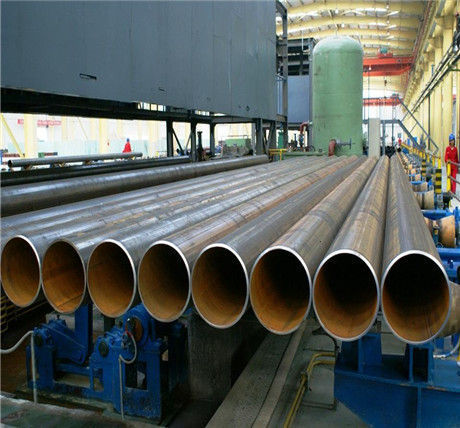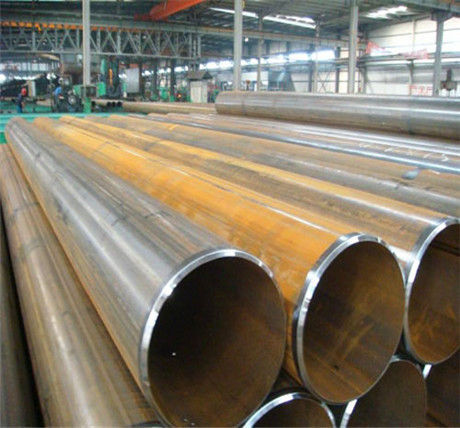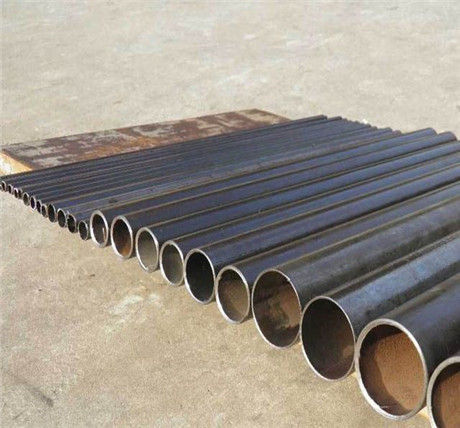14
2023
-
08
Submerged arc welded straight seam steel pipes for natural gas transmission
Author:
Submerged arc welded straight seam steel pipe Description of the main production process of longitudinal welded pipe for building structure: 1. Plate exploration: after the steel plate used to manufacture large-diameter submerged arc welded straight seam steel pipe enters the production line, the whole plate ultrasonic inspection is first carried out; 2. Milling edge: double-sided milling of the two edges of the steel plate through the edge milling machine to achieve the required plate width, plate edge parallelism and groove shape; 3. Pre-bending edge: use the pre-bending machine to pre-bend the board edge, so that the board edge has the curvature that meets the requirements; 4. Forming: On the JCO forming machine, first half of the pre-bent steel plate is stamped in multiple steps and pressed into a "J" shape, and then the other half of the steel plate is also bent and pressed into a "C" shape, * forming an open "O" shape 5. Pre-welding: make the formed straight seam welded steel pipe seam and use gas shielded welding (MAG) for continuous welding; 6. Internal welding: longitudinal multi-filament submerged arc welding (* can be more than four wires) is used to weld the inside of the straight seam steel pipe; 7. External welding: longitudinal multifilament submerged arc welding is used to weld the outside of the straight seam submerged arc welded steel pipe; 8. Ultrasonic inspection: 100% inspection of the inner and outer welds of the straight seam welded steel pipe and the base metal on both sides of the weld; 9. X-ray inspection: 100% X-ray industrial TV inspection of internal and external welds, using image processing system to ensure the sensitivity of flaw detection;
Submerged arc welded straight seam steel pipe
Description of the main production process of longitudinal welded pipe for building structure:
1. Plate exploration: after the steel plate used to manufacture large-diameter submerged arc welded straight seam steel pipe enters the production line, the whole plate ultrasonic inspection is first carried out;
2. Milling edge: double-sided milling of the two edges of the steel plate through the edge milling machine to achieve the required plate width, plate edge parallelism and groove shape;
3. Pre-bending edge: use the pre-bending machine to pre-bend the board edge, so that the board edge has the curvature that meets the requirements;
4. Forming: On the JCO forming machine, first half of the pre-bent steel plate is stamped in multiple steps and pressed into a "J" shape, and then the other half of the steel plate is also bent and pressed into a "C" shape, * forming an open "O" shape
5. Pre-welding: make the formed straight seam welded steel pipe seam and use gas shielded welding (MAG) for continuous welding;
6. Internal welding: longitudinal multi-filament submerged arc welding (* can be more than four wires) is used to weld the inside of the straight seam steel pipe;
7. External welding: longitudinal multifilament submerged arc welding is used to weld the outside of the straight seam submerged arc welded steel pipe;
8. Ultrasonic inspection: 100% inspection of the inner and outer welds of the straight seam welded steel pipe and the base metal on both sides of the weld;
9. X-ray inspection: 100% X-ray industrial TV inspection of internal and external welds, using image processing system to ensure the sensitivity of flaw detection;

10. Diameter expansion: expand the full length of the submerged arc welded straight seam steel pipe to improve the dimensional accuracy of the steel pipe and improve the distribution state of the stress in the steel pipe;
11. Hydrostatic test: the expanded steel pipe is inspected one by one on the hydrostatic testing machine to ensure that the steel pipe meets the test pressure required by the standard, and the machine has automatic recording and storage functions;
12. Chamfering: the steel pipe after passing the inspection is processed at the pipe end to achieve the required pipe end groove size;
13. Ultrasonic inspection: ultrasonic inspection is carried out again one by one to check the possible defects of the straight seam welded steel pipe after diameter expansion and water pressure;
14. X-ray inspection: X-ray industrial TV inspection and pipe end weld filming of steel pipe after diameter expansion and hydrostatic test;
15. Tube-end magnetic particle inspection: this inspection is carried out to find the pipe end defect;
16. Anti-corrosion and coating: The qualified steel pipe is anti-corrosion and coated according to user requirements.
Submerged arc welded straight seam steel pipe

Straight seam steel pipe chamfer: the steel pipe after passing the inspection is processed at the pipe end to reach the required pipe end groove size; The main implementation standards are GB/T3091, GB/T9711, API In general, shot peening rust removal is mainly used for pipe inner surface treatment, shot blasting rust removal is mainly used for the outer surface treatment of straight seam steel pipe, using this rust removal grade can almost remove all oxide scale, rust and other dirt, anchor depth of 40~100μm fully meet the adhesion requirements of the anti-corrosion layer and the steel pipe, and the spray (throw) rust removal process can reach the near white level with low operating costs and stable and reliable quality ( SA2.5 technical conditions The swing welding technology of straight seam steel pipe should pay attention to several points 4. Adapt to a wide range of varieties and specifications, diameter 6-3100mm, wall thickness of 0.3-35mm 1. Ultrasonic flaw detection of steel plate: used to manufacture large-diameter straight seam submerged arc welded steel pipe after the steel plate enters the production line, the whole plate ultrasonic inspection is carried out at the beginning; the production process of large-diameter straight seam steel pipe generally includes hot rolling, hot coiling, casting and other production methods, large-diameter thick-walled steel pipe will generally use double-sided submerged arc welding production process when processing, and the product is bent, seam, internal welding, external welding, straightening, flat head and other processes, to meet the requirements of American petrochemical standards Generally speaking, shot peening rust removal is mainly used for the inner surface treatment of pipes, and shot blasting rust removal is mainly used for the outer surface treatment of straight seam steel pipes.

The steel pipes produced by our company have been inspected by 100% internal weld inspection and 100% X-ray inspection (there is no blind zone at the pipe end); 100% hydrostatic test (hydrostatic test adopts face sealing, and the dead zone of the pipe end is reduced to *small); 100% visual inspection (including internal and external welds and base metal surfaces). Our laboratory is equipped with advanced testing equipment, such as imported SPEX direct reading spectrometer, digital tensile testing machine, etc., which can carry out accurate chemical analysis of products for mechanical property testing; Online ultrasonic automatic flaw detection device and X-ray industrial flaw detection device, can carry out 100% non-destructive testing of products, hydrostatic test automatic discipliner can ensure that each steel pipe according to the specified pressure, time for pressure test and holding. Products and various inspection processes are responsible for engineers for technical responsibility and guidance, all inspectors have professional technical training, non-destructive personnel hold non-destructive testing grade certificates. From personnel to equipment, we can ensure that the quality inspection of products is strictly carried out according to standards to ensure that the quality of products leaving the factory meets the standard requirements.

In 2018, the overall steel capacity reduction task is still relatively heavy, in order to better adapt to the new situation, new changes and new requirements of the new stage of capacity reduction, the combination of capacity reduction and structural adjustment will continue to consolidate the results of resolving steel excess capacity, and further promote the transformation and upgrading of steel enterprises and structural optimization. In 2018, the work of resolving excess capacity in steel, coal, coal power and other industries was actively and orderly advanced. From January to July, about 80 million tons of coal production capacity were withdrawn, completing more than 50% of the annual task of 150 million tons; Reducing crude steel production capacity by 24.7 million tons, completing more than 80% of the annual task of 30 million tons, reducing production capacity to promote the capacity utilization rate of steel, coal, coal power and other industries to increase significantly, the relationship between supply and demand has been significantly improved, and the efficiency of enterprises has continued to improve. In the first half of the year, the profit margins of enterprises above designated size in the steel, coal and power industries increased by 93.4%, 18.4% and 28.1% respectively.
Next Page

